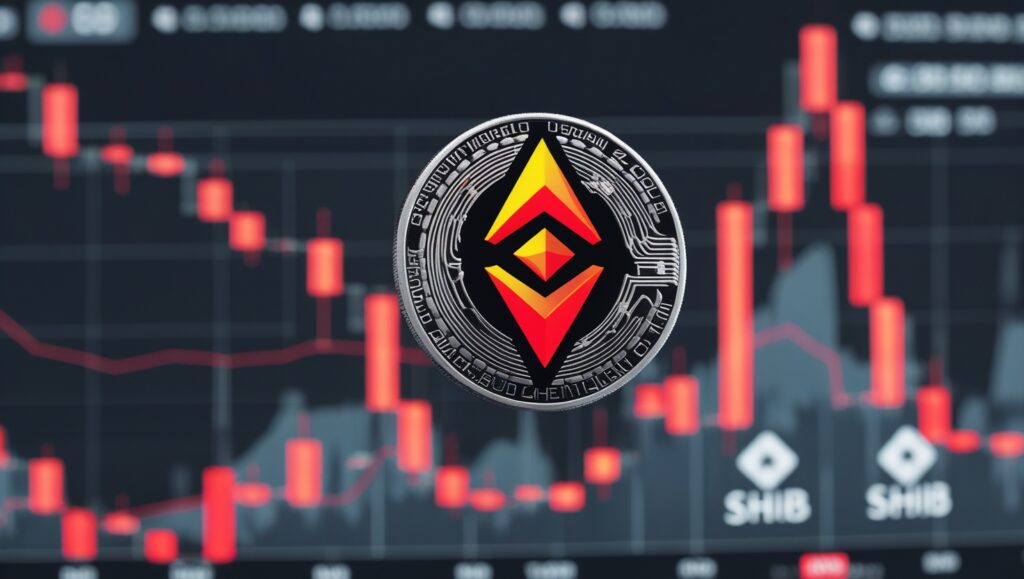
TL;DR
- SHIB’s daily burn rate dropped by 63%, weakening its deflationary tokenomics.
- Despite recovering from $0.00001234 to $0.00001265, SHIB remains in a macro downtrend.
- On-chain data suggests strong support near $0.000012–$0.000013, where investor cost bases are concentrated.
- Volume increased by 78%, indicating potential accumulation at lower levels.
- Analysts point to continued technical weakness unless SHIB breaks out above key trendline resistance.
Burn Rate Decline Threatens SHIB’s Deflationary Narrative
Shiba Inu (SHIB) continues to face technical and sentiment-driven headwinds, despite a mild recovery from overnight lows. As of this writing, SHIB trades near $0.000012650, up modestly from a session bottom of $0.00001234 during Asian trading hours. However, the broader downtrend structure remains intact, aligned with declining on-chain fundamentals.
The most critical setback was a 63% drop in the daily token burn rate, as tracked by CoinDesk AI Insights. This metric tracks the number of SHIB tokens permanently removed from circulation, a key mechanism in maintaining deflationary tokenomics.
“Without consistent burns, the core appeal of SHIB as a deflationary token is significantly weakened,” analysts at CD Analytics noted.
SHIB On-Chain & Technical Overview
| Metric | Value | Trend |
| Current Price | $0.00 | ▼ Downtrend intact |
| 24h Low / High | $0.00001234 / $0.00001281 | Mild intraday bounce |
| Burn Rate Change | ▼ 63% | Deflationary pressure |
| Trading Volume Change | ▲ 78% | Increased market activity |
| Support Levels | $0.000012 – $0.000013 | Based on wallet clusters |
Shiba Inu’s Downtrend Still Dominates Chart Patterns
Technically, SHIB remains in a confirmed downtrend, identified by descending trendlines connecting highs from May 12 and May 23, and the low from May 17. The current bounce appears corrective, lacking the momentum necessary to flip broader sentiment.
The token’s structure reflects lower highs and lower lows, with resistance building near the $0.000013 level. Until SHIB breaks above this resistance zone with strong volume, any rallies are likely to be capped.
Token Burn Mechanics: A Fading Deflationary Edge?
Token burning is widely adopted across the crypto ecosystem to introduce a scarcity-driven valuation model. By removing tokens from circulation permanently, projects like Shiba Inu aim to reduce total supply and increase long-term price pressure.
However, with SHIB’s burn rate plummeting by 63%, that foundational deflationary narrative is in jeopardy.
“The community-led burn efforts need consistency and velocity to have a material impact on market dynamics,” said a report from Omkar Godbole, Senior Markets Editor at CoinDesk.
If burn momentum doesn’t recover, the broader market may reevaluate SHIB’s long-term utility and value proposition.
Accumulation Zones: On-Chain Data Offers a Glimmer of Hope
Despite macro bearishness, on-chain analytics suggest strong investor activity near the $0.000012–$0.000013 range. Many wallets hold SHIB tokens acquired at these prices, which may act as psychological and technical support.
Notably:
- A volume spike at 08:02 UTC registered over 14.9 billion SHIB tokens traded, marking a possible accumulation point.
- The price rebounded from $0.00001236 and stabilized, a potential sign of buyer defense at critical levels.
- Late-session trading suggested sideways movement, often preceding volatility-driven moves.
Market Sentiment: High Volume Meets Uncertainty
SHIB’s 78% increase in trading volume hints at rising speculative interest. Whether this translates into breakout momentum or short-lived volatility depends on two factors:
- Recovery in the burn rate, possibly driven by renewed community engagement or automated mechanisms.
- Breakout above $0.000013, which would invalidate the current downtrend and invite fresh capital inflows.
Until then, SHIB remains vulnerable to macro sentiment swings and on-chain metric deterioration.
Outlook: Will SHIB Find a Floor?
In the short term, technical consolidation between $0.000012 and $0.000013 is likely. If buyers can maintain this support zone and burn mechanics stabilize, a relief rally is possible.
However, without structural changes or new catalysts, SHIB’s deflationary thesis remains fragile, and long-term recovery will be challenging.




